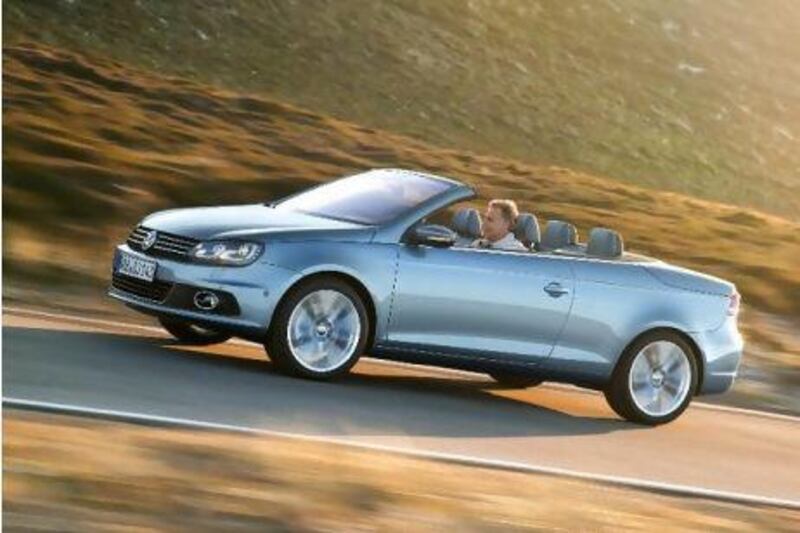Greek mythology has a deity for pretty much everything under the sun, and above it. And the sun itself. Had Volkswagen decided to pick the name of that particular god for its new convertible in 2006, we'd now be reviewing the revised VW Helios.
There's probably no more obvious god to name a drophead after. Sure enough, about the time VW would have been brainstorming the name for its new convertible, in 2005, Chrysler unveiled the ASC Helios. It was based on the 300C and never saw the light of day.
So, Helios taken (and wasted), Volkswagen chose Eos, the Greek goddess of the dawn. And it was sort of a new dawn for the company, if you want to get all poetic about it. That's because, even though it technically replaced the Golf Cabriolet, which had died in 2002, it did so with a new name and in a far more upmarket fashion.
Upmarket by way of its fancy five-piece metal folding hardtop (all Golf Cabriolets have had fabric roofs), with upmarket interior and price tag to match.
It worked a treat, too, serving up coupé-like refinement with the roof up, coupled with the usual wind-and-Gucci-shades thrills that all gluten-free lunch quaffing convertible drivers dig.
That was 2006. It's 2011 now: facelift time. And good job too, because since 2006 the Eos has gained a few enemies in the medium-sized convertible sector - good ones - so it needs to shape up a little.
Cars like the Peugeot's 308CC, much improved over the preceding 307CC; the Renault Mégane Coupé-Cabriolet; the Audi A3 Cabriolet; and the BMW 1 Series Convertible.
So what has Volkswagen done to combat France and Germany's finest? Some horizontal grille lines, so it looks more like the new Passat and the Golf, a bit of new trim and the mildest of equipment shuffles.
But to tell the truth, there's not a great deal more Volkswagen needed to do. Eos, the Greek god, was known for her outstanding beauty, and while it might be a little dramatic to describe the eponymous car that way, it always was the best looking of its rivals. It still is.
And all the things that made it so appealing, and allowed Volkswagen to charge that bit more for it than a French company could command, remain. Only the Audi A3 Cabriolet is in the same league as the Eos for refinement and quality.
We've driven the new base model, powered by a 1.4L TSI petrol engine that uses a turbocharger to get 122hp from its small capacity. True, it's still not a great deal of power, and the weight of the Eos, with all its thick, squashy dashboard plastic and complicated folding roof magic, means it struggles slightly.
But, importantly, it's a stoic engine, struggling without too much noise or drama. Basically, keep this Eos at a gentle cruise and it's fine. Plus, it uses 6.2L/100km on the combined cycle, which isn't at all bad for a petrol car. BlueMotion Technology features such as stop-start make that possible and mean you don't have to live with a clattering diesel.
You can't here anyway, as the diesel isn't available in the UAE, but the 140hp 2.0L TDI to be had in other markets will at least dish up more poke. There's also a 160hp version of the 1.4L TSI and a flagship 2.0L TSI, which is the 210hp engine from the Golf GTI.
Funnily enough, driving an Eos is like driving a Golf. Unusually for a quite small, four-seat convertible, it seats four people of life size - and the driver will find it harder to get an uncomfortable driving position than a good one.
There's that typical Volkswagen blandness in the cabin, but one person's sober is another's sophisticated; everything is placed intuitively, is clear and is damped to premium German perfection. It's actually quite endearing.
It's a road tester's prerogative when driving any convertible to get out his or her standard issue scuttle shake monitor and check for any wobble in the chassis - it's the legacy of old convertibles, which flexed like open cardboard boxes. But as is becoming increasingly common, the Eos is shake-free to the point that most wouldn't notice. Sure, there is a touch more harshness to the ride if the road is particularly poor, but nothing to worry about.
The main issue the Eos has, if any, is noticeable wind noise from the gap between roof and windscreen pillars, but again, nothing to shout about. It's arguably more impressive with the roof down because it's calmer in the cabin in that state than most of these types of car. Obviously the appeal of a convertible lies, somehow, in that feeling of wind and flies hitting your forehead, but in some cars the buffeting is off-putting. Not here. And if it does get too much, or it starts to rain, the roof is up 25 seconds after you press the little button on the centre console.
So, very impressive. But there's one thing we've yet to mention, and it's a big deal: the Volkswagen Golf Cabriolet.
Yes, VW now effectively has two convertible Golfs, except one of them has a soft top, is cheaper and is actually called a Golf.
Volkswagen will argue that the fabric of the Golf Cabriolet's roof separates it enough from the metal-topped Eos for the two to co-exist. But, really, the soft-top is so good that it virtually renders the Eos redundant. And it adds bigger boot space into the bargain.
The Golf's arrival hardly shrouds the Eos in darkness - it's still an excellent convertible - but, in truth, it has overshadowed what should have been a much brighter dawn for the revised Eos. The saving grace? The Golf Cabriolet isn't available in the UAE either.
The Specs
Base price / as tested Dh125,000 / Dh136,000
Engine 1.4L four cylinder
Gearbox Six-speed automatic
Power 122hp @ 5,500rpm
Torque 200Nm @ 1,500rpm
Fuel economy, combined 6.2 L/100km






